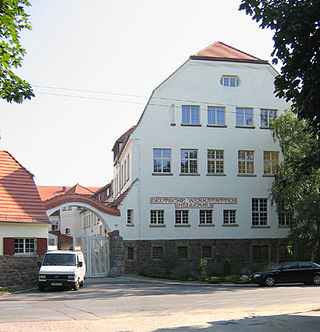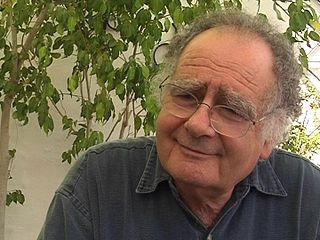
Count Ferdinand von Zeppelin was a German general and later inventor of the Zeppelin rigid airships. His name soon became synonymous with airships and dominated long-distance flight until the 1930s. He founded the company Luftschiffbau Zeppelin.

Klaus von Klitzing is a German physicist, known for discovery of the integer quantum Hall effect, for which he was awarded the 1985 Nobel Prize in Physics.

Schussenried Abbey is a former Catholic monastery in Bad Schussenried, Baden-Württemberg, Germany. It is famed for its Baroque library hall. The abbey was established in the 12th century by the Premonstratensian Order and made an Imperial Abbey in the 15th century. The monastery sustained immense damage in the Thirty Years' War. In the 18th century, the abbey began expansions in the Baroque style, but was unable to complete them. The abbey was secularized in 1803 and twice awarded during the process of German Mediatization, eventually becoming a possession of the Kingdom of Württemberg. Its second king, William I, opened a foundry on its grounds, which was followed by a nursing home. These ceased operation or moved out of the monastery in the 1990s.

John Axel Prip, also known as Jack Prip (1922–2009), was an American master metalsmith, industrial designer, and educator. He was known for setting standards of excellence in American metalsmithing. His works and designs have become famous for bringing together the formal, technical tradition of Danish design into harmony with the American desire for innovation. Several of his designs for the Reed and Barton Company are still in production today.

Dettingen an der Erms is a town in the district of Reutlingen in Baden-Württemberg in Germany. The town about twelve kilometers north-east of Reutlingen in Baden-Wuerttemberg or about 46 kilometers from Stuttgart. The municipality belongs to the metropolitan region of Stuttgart.

Diane, Dowager Duchess of Württemberg is a French-German painter, sculptor, writer and philanthropist. She is the widow of Carl, Duke of Württemberg, head of the House of Württemberg. She is the fourth daughter and sixth child of Henri, Count of Paris, Orléanist pretender to the throne of France, and his wife, Princess Isabelle of Orléans-Braganza.

Richard Riemerschmid was a German architect, painter, designer and city planner from Munich. He was a major figure in Jugendstil, the German form of Art Nouveau, and a founder of architecture in the style. A founder member of both the Vereinigte Werkstätte für Kunst im Handwerk and the Deutscher Werkbund and the director of art and design institutions in Munich and Cologne, he prized craftsmanship but also pioneered machine production of artistically designed objects.
John Rais is a designer, blacksmith and sculptor known for his architectural work, vessels, and furniture. Rais primarily works in steel as well as titanium, bronze, copper, stainless steel, and other materials. He is well known for his one-of-a-kind firescreens. Rais was born and raised in Burlington, Massachusetts, the youngest of seven children. Rais was introduced to blacksmithing in a sculpture class at the age of 18. He went to college at the Massachusetts College of Art, graduating in 1995, BFA Sculpture. After working at an architectural ironworks and a living history museum in Massachusetts, he decided to go to graduate school. Rais received his masters of fine arts degree from Cranbrook Academy of Art in 1998, after which he worked at Peters Valley Craft Center as a department head. Rais was a department head of blacksmithing at Peter's Valley from 1998 to 2001. He has run his own design and metalsmithing studio since 1998. He now resides in Philadelphia, PA.

Micha Ullman is an Israeli sculptor and professor of art.
L. Brent Kington was an art educator and visual artist who worked in blacksmithing and sculpture. Kington was a product of the studio craft movement in jewelry and hollowware. In 1969 he served as the first president of the Society of North American Goldsmiths. He is frequently hailed as the man responsible for the blacksmithing revival which took place in the late 1960s and early 1970s.
Gary Lee Noffke is an American artist and metalsmith. Known for versatility and originality, he is a blacksmith, coppersmith, silversmith, goldsmith, and toolmaker. He has produced gold and silver hollowware, cutlery, jewelry, and forged steelware. Noffke is noted for his technical versatility, his pioneering research into hot forging, the introduction of new alloys, and his ability to both build on and challenge traditional techniques. He has been called the metalsmith's metalsmith, a pacesetter, and a maverick. He is also an educator who has mentored an entire generation of metalsmiths. He has received numerous awards and honors. He has exhibited internationally, and his work is represented in collections around the world.

Tom Joyce is a sculptor and MacArthur Fellow known for his work in forged steel and cast iron. Using skills and technology acquired through early training as a blacksmith, Joyce addresses the environmental, political, and social implications of using iron in his work. Exhibited internationally since the 1980s, his work is included in 30-plus public collections in the U.S. and abroad. Joyce works from studios in Santa Fe, New Mexico, and since 2012, in Brussels, Belgium, producing sculpture, drawings, prints, photographs, and videos that reference themes of iron in the human body, iron in industry, and iron in nature.

John Paul Miller was an American jewellery designer and goldsmith, who also produced films, photographs and paintings. Stephen Harrison, decorative arts curator at the Cleveland Museum of Art, compares Miller's work with that of René Lalique and Louis Comfort Tiffany.
Paul J. Smith was an arts administrator, curator, and artist based in New York. Smith was professionally involved with the art, craft, and design fields since the early 1950s and was closely associated with the twentieth-century studio craft movement in the United States. He joined the staff of the American Craftsmen's Council in 1957, and in 1963 was appointed Director of the Museum of Contemporary Crafts, a position he held for the next 25 years. In September 1987, he assumed the title of director emeritus and continued to work as an independent curator and consultant for museums, arts organizations, and collectors.
Myra Mimlitsch-Gray is an American metalsmith, artist, critic, and educator living and working in Stone Ridge, New York. Mimlitsch-Gray's work has been shown nationally at such venues as the John Michael Kohler Arts Center, Museum of the City of New York, Metropolitan Museum of Art, Cooper-Hewitt Smithsonian Design Museum, and Museum of Arts and Design. Her work has shown internationally at such venues as the Middlesbrough Institute of Modern Art, Stadtisches Museum Gottingen, and the Victoria and Albert Museum, and is held in public and private collections in the U.S, Europe, and Asia.
Walter Adolf Giers was a German light, sound and media artist and a pioneer of electronic art.

The Pliezhausen brooch is a gold disc decorated with figures that was discovered in 1928 during excavations in Pliezhausen, in the county of Reutlingen in Germany, in the grave of a wealthy Alemannic woman dating to the early 7th century and which was the front of a disc fibula. It is one of the few artifacts of the Early Middle Ages which portrays the figures of people.

Bruchsal Palace, also called the Damiansburg, is a Baroque palace complex located in Bruchsal, Germany. The complex is made up of over 50 buildings. These include a three-winged residential building with an attached chapel, four pavilions separated by a road, some smaller utility buildings, and a garden. It is noted for its fine Roccoco decoration and in particular its entrance staircase, which is regarded as one of the finest examples of its kind in any Baroque palace.
Giovanni Corvaja is an Italian jewellery artist known for fine wire work.

Mergentheim Palace is a historic building located in Bad Mergentheim, Germany. The palace was first a castle, built in the early Middle Ages as the seat of the Taubergau, but then became a Teutonic possession in 1219, and then seat of the Mergentheim Commandery. The castle became the residence of the Grand Master of the Teutonic Order in 1527 and remained the headquarters of the Order until 1809.














